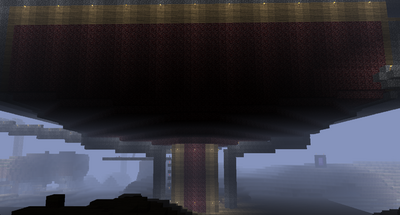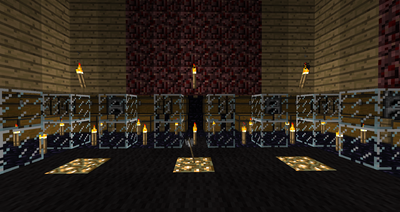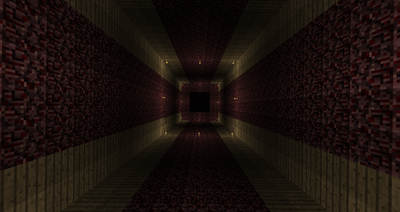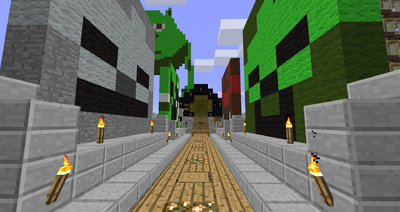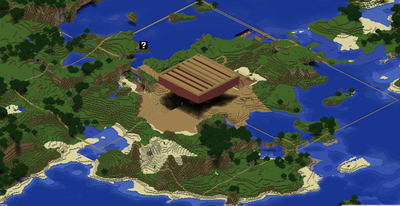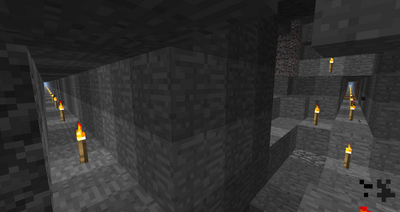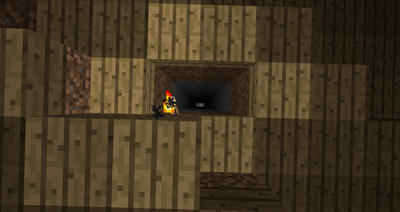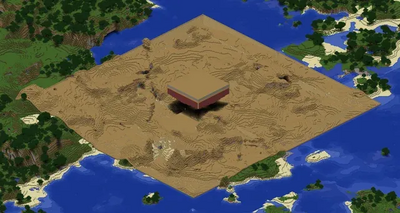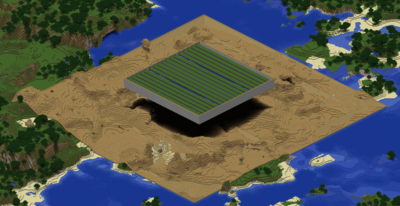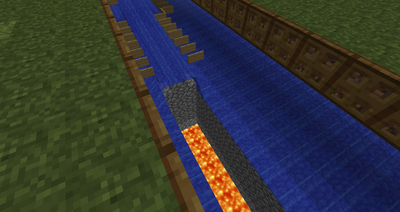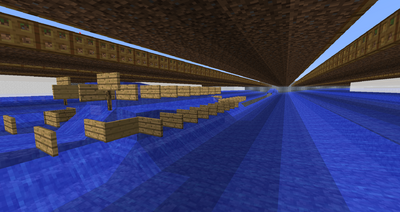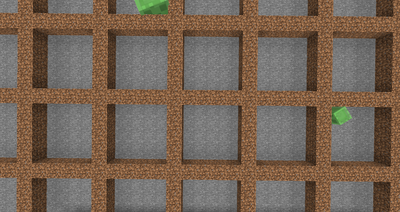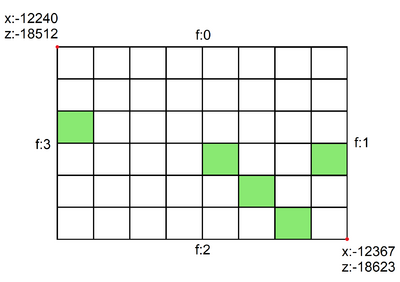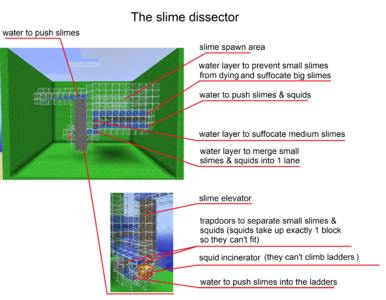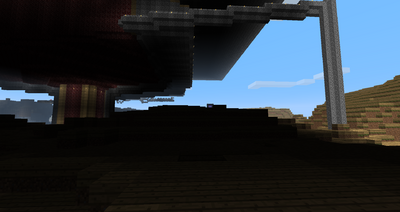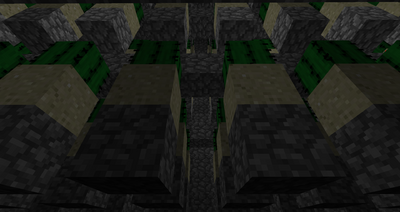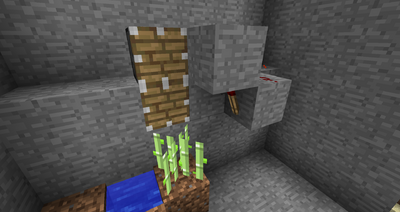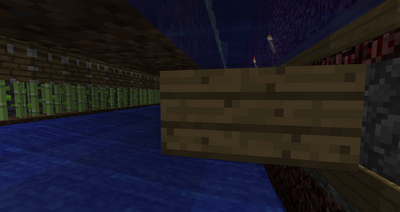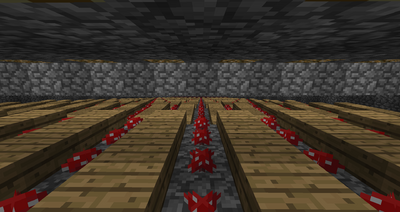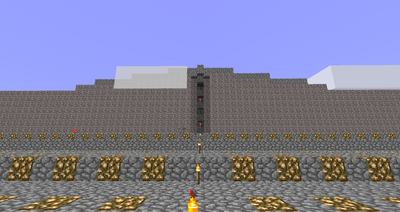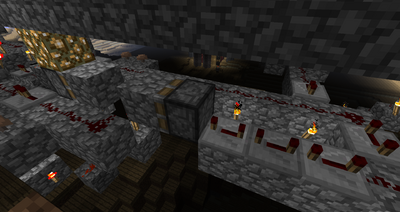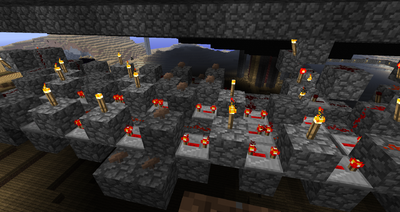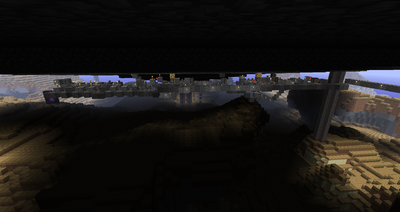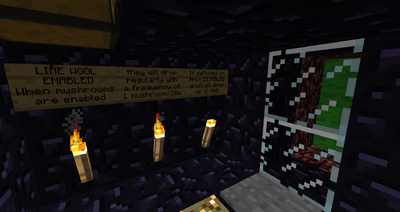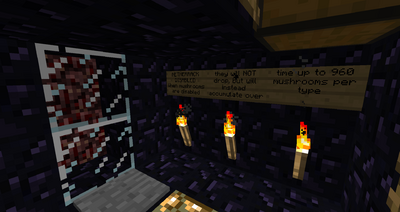Grinder
| Grinder | |||
|---|---|---|---|
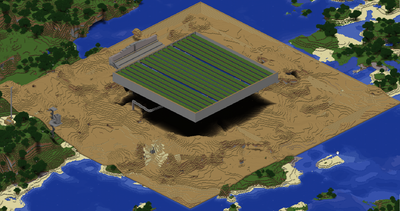 | |||
| Owner | |||
 NonSkilledMan NonSkilledMan | |||
| Town Members | |||
| None | |||
| Assistants | |||
| None | |||
| General information | |||
| |||
| |||
Grinder is a town owned by
 NonSkilledMan and located at [x:-12302; y:42; z -814]. This place can hardly be called a town, because it has neither any additional members nor activity, and only utilizes area protection from it. The entire town consists of a singular mega-structure, which in its turn consists of many smaller parts. The corners of the Grinder are located at coordinates [x: -12140; z: -18724] and [x: -12468; z: -18412], therefore it is 328x312 blocks in size or 19.5x20.5 chunks (the region is not a square since the creator decided that he wanted a 2 chunk center). It has been designed as a completely public tool to easily acquire every single automatable material on the overworld, namely: bones, arrows, string, sulfur, feathers, slimeballs, ink sacks, wool, pork, cooked pork, leather, cactus, sugarcane, brown mushrooms and red mushrooms.
NonSkilledMan and located at [x:-12302; y:42; z -814]. This place can hardly be called a town, because it has neither any additional members nor activity, and only utilizes area protection from it. The entire town consists of a singular mega-structure, which in its turn consists of many smaller parts. The corners of the Grinder are located at coordinates [x: -12140; z: -18724] and [x: -12468; z: -18412], therefore it is 328x312 blocks in size or 19.5x20.5 chunks (the region is not a square since the creator decided that he wanted a 2 chunk center). It has been designed as a completely public tool to easily acquire every single automatable material on the overworld, namely: bones, arrows, string, sulfur, feathers, slimeballs, ink sacks, wool, pork, cooked pork, leather, cactus, sugarcane, brown mushrooms and red mushrooms.
Idea Origin
Originally the idea of constructing this monstrosity came from a desire to single-handedly break server's economy via devaluing some resources and griefing what can be griefed with an infinite supply of TNT. The intentions weren't as kind-hearted as they ended up to be...
Construction
Preparation
To build a huge thing you need a large space and lots of time.
 NonSkilledMan was not aware that he could protect his creations with towns at the time, hence the late town creation date, where the construction actually began in the middle of June 2021. So in order to protect the future creation from strangers he had to travel as far away as possible, planning to travel more than 100k+ blocks via nether travel. Little did he know, that the server's border radius is only 30k blocks. Upon realizing the unfortunate news, he checked the server's world map and decided to start the construction at a place, which is the furthest away from any loaded chunks to ensure his safety. It was decided to leave the nether portal at the coordinates where the Grinder sits today, [x:-12302; y:42; z -814].
NonSkilledMan was not aware that he could protect his creations with towns at the time, hence the late town creation date, where the construction actually began in the middle of June 2021. So in order to protect the future creation from strangers he had to travel as far away as possible, planning to travel more than 100k+ blocks via nether travel. Little did he know, that the server's border radius is only 30k blocks. Upon realizing the unfortunate news, he checked the server's world map and decided to start the construction at a place, which is the furthest away from any loaded chunks to ensure his safety. It was decided to leave the nether portal at the coordinates where the Grinder sits today, [x:-12302; y:42; z -814].
The Grinder Base
The first thing which comes to mind when you hear the word "Mob grinder" is a big mushroom shaped structure, which is knows to be efficient at farming mobs via fall damage. These are most popular in SkyBLock, because there is no other place for mobs to spawn other than the grinder itself.
 NonSkilledMan was aware of that, but he did not know it would take, so he left it for later. For now he used his accumulated stocks of netherrack from nether travel to build the mushroom stem along with the area the mobs are supposed to spawn. The mushroom stem has to be thick in order to leave enough of an open area for spiders not to climb onto walls. The spawning area was wood-costly, consisting of many platforms with trapdoors on the sides, so chopping down a lot of birch was required. The collection area ended up being a simple opening where you had to walk under falling mobs, and since he didn't know about town protection yet, he of course made the entire room out of obsidian via pouring a lot of lava and water.
NonSkilledMan was aware of that, but he did not know it would take, so he left it for later. For now he used his accumulated stocks of netherrack from nether travel to build the mushroom stem along with the area the mobs are supposed to spawn. The mushroom stem has to be thick in order to leave enough of an open area for spiders not to climb onto walls. The spawning area was wood-costly, consisting of many platforms with trapdoors on the sides, so chopping down a lot of birch was required. The collection area ended up being a simple opening where you had to walk under falling mobs, and since he didn't know about town protection yet, he of course made the entire room out of obsidian via pouring a lot of lava and water.
 matheus later helped to design a better looking collection area and
matheus later helped to design a better looking collection area and
 TheFurryShark linked the Grinder to SharkCity and spawn via previously built StarGate at [x: -158; z: -32], who also much later added gold blocks for better aesthetics.
TheFurryShark linked the Grinder to SharkCity and spawn via previously built StarGate at [x: -158; z: -32], who also much later added gold blocks for better aesthetics.
-
Grinder stem
-
Grinder collection area
-
Grinder's stem on the inside
-
StarGate to the Grinder near spawn
Evaporation
One of the most annoying creatures to encounter while trying to minimize mob spawns are squids. Any outside body of water has to be completely removed. Fortunately for
 NonSkilledMan, he has gathered enough money to buy around 5 sponges, which with the help of server's plugins are able to infinitely remove water within 5x5x5 block volume. The process still takes an awfully long amount of time before all of the water is removed.
NonSkilledMan, he has gathered enough money to buy around 5 sponges, which with the help of server's plugins are able to infinitely remove water within 5x5x5 block volume. The process still takes an awfully long amount of time before all of the water is removed.
Slabification
The absolute hardest part which would test the creator's willpower is without a doubt slab coverage. It is necessary to prevent passive mobs from spawning, since removing all dirt blocks by hand is much slower. The Grinder would end up costing approximately 100.000 wooden slabs, around 80% of which were obtained through manual labor: cutting down birch. And since you only get 3 slabs out of 3 planks, that meant that this step of constructon would require 25.000 logs. Around 80 hours was spent purely on placing those slabs.
-
Slabification and evaporation
Illumination
Now that the squids and other passive mobs are mostly dealt with (squids still exist within cave waters), it is time to take care of hostiles. To do that,
 NonSkilledMan had to light up all caves and small spots within borders of the Grinder, which is impossible with just F3 (it is used to x-ray mobs though blocks by their ids). And so, the creator, being a fair player, decided to drill vertical holes every 20 blocks inside the border and also horizontal ones for easier travel and better insurance. These holes will be used to locate big caves, water caves and possibly small caves as well. This step is one of the most dangerous ones, because even if you dig down 2 blocks at a time instead of 1, which would be suicidal, you'll still be making countless traps spread around all of the area, waiting for you to fall. The process was as boring and tedious as placing slabs, since at least 255 holes had to be dug up.
NonSkilledMan had to light up all caves and small spots within borders of the Grinder, which is impossible with just F3 (it is used to x-ray mobs though blocks by their ids). And so, the creator, being a fair player, decided to drill vertical holes every 20 blocks inside the border and also horizontal ones for easier travel and better insurance. These holes will be used to locate big caves, water caves and possibly small caves as well. This step is one of the most dangerous ones, because even if you dig down 2 blocks at a time instead of 1, which would be suicidal, you'll still be making countless traps spread around all of the area, waiting for you to fall. The process was as boring and tedious as placing slabs, since at least 255 holes had to be dug up.
-
Horizontal canals beneath the Grinder's border
-
One of many vertical holes
Expansion
After going through the toughest of processes imaginable in this version,
 NonSkilledMan was left disappointed after he found out, that mobs don't actually despawn outside the render distance, but rather a couple of blocks further, thanks to
NonSkilledMan was left disappointed after he found out, that mobs don't actually despawn outside the render distance, but rather a couple of blocks further, thanks to
 Orknarok_666. The solution was to expand the Grinder borders by 20 blocks in all directions. The news were saddening, but you gotta do what you gotta do. So the previous 3 steps had to be repeated once more. At this point the owner had to take a 2 year break from the grind due to the lack of motivation, after which the town was finally made official and published on Discord, therefore making the Grinder public.
Orknarok_666. The solution was to expand the Grinder borders by 20 blocks in all directions. The news were saddening, but you gotta do what you gotta do. So the previous 3 steps had to be repeated once more. At this point the owner had to take a 2 year break from the grind due to the lack of motivation, after which the town was finally made official and published on Discord, therefore making the Grinder public.
-
Completed hostile mob Grinder
Passive mob grinder
Now that the hostile mobs are finally done and are working properly,
 NonSkilledMan felt much more motivated to continue the work and made himself a challenge to automate everything possible on the surface. The first obvious step would be to introduce passive mobs, which can only spawn on grass blocks under open sky, which limited the area to being just one layer tall. Because of this, the passive mob area had to be much wider than what was used for hostile mobs. There was 1 mob that needed special attention: chickens. Chickens go against the whole idea of dying to fall damage, which was the only way to kill mobs, so it was decided to create a chicken incinerator, which would fry the birds, but let other mobs through. This can be archived via reaching maximum fall speed, which needed extra blocks for acceleration, 4 to be exact, where there's a possibility of them dying in the air to fire damage, which also allowed the grinder to produce cooked pork as well. However,
NonSkilledMan felt much more motivated to continue the work and made himself a challenge to automate everything possible on the surface. The first obvious step would be to introduce passive mobs, which can only spawn on grass blocks under open sky, which limited the area to being just one layer tall. Because of this, the passive mob area had to be much wider than what was used for hostile mobs. There was 1 mob that needed special attention: chickens. Chickens go against the whole idea of dying to fall damage, which was the only way to kill mobs, so it was decided to create a chicken incinerator, which would fry the birds, but let other mobs through. This can be archived via reaching maximum fall speed, which needed extra blocks for acceleration, 4 to be exact, where there's a possibility of them dying in the air to fire damage, which also allowed the grinder to produce cooked pork as well. However,
 NonSkilledMan was way too cautious with height of the grinder, which resulted in him making it too short, and so he had to come up with an idea on how to make a perpendicular waterway which was 2 blocks wide and right next to other water blocks. He asked some help from
NonSkilledMan was way too cautious with height of the grinder, which resulted in him making it too short, and so he had to come up with an idea on how to make a perpendicular waterway which was 2 blocks wide and right next to other water blocks. He asked some help from
 Ingrate but eventually came up with a solution on his own.
Ingrate but eventually came up with a solution on his own.
-
Completed passive mob Grinder
-
Chicken incinerator
-
Perpendicular waterway
Slime grinder
To finish mob loot production there's only slimes left, which are the hardest of the mobs to automate because of their complexity. This process itself can be divided into sub-steps:
1. Finding slime chunks. Slimes don't just spawn anywhere under y=16 (it has been chosen to spawn slimes on y=13 for safety), they spawn within randomly generated chunks, which by fair means can only be found via the chunk grid method;
2. Dissecting slimes. Since it is impossible to make loot up up without over-complicated piston mechanisms, the slimes themselves will have to go up. The idea is that slimes have to be dissected into their smallest forms first, after which they can be safely transported to the top of the grinder stem, so that they can fall down from there along with other mobs.
 NonSkilledMan was not able to find any guide on how to dissect medium and large slimes into small ones, so he had to experiment. He ended up making a schematic, which would be able to do this very job via suffocating non-small slimes and preventing small slimes from dying to fall damage. The height of the structure was barely enough to fit above the bedrock level. Because squids don't climb on ladders, a separate incinerator for them is also made. And conveniently we can forget about sorting out hostile mobs, since slimes can spawn in a lighted area.
NonSkilledMan was not able to find any guide on how to dissect medium and large slimes into small ones, so he had to experiment. He ended up making a schematic, which would be able to do this very job via suffocating non-small slimes and preventing small slimes from dying to fall damage. The height of the structure was barely enough to fit above the bedrock level. Because squids don't climb on ladders, a separate incinerator for them is also made. And conveniently we can forget about sorting out hostile mobs, since slimes can spawn in a lighted area.
 TellTheL helped him a little bit with collecting the signs, of which he needed around 3000, so that meant more chopping time;
TellTheL helped him a little bit with collecting the signs, of which he needed around 3000, so that meant more chopping time;
3. Slime transportation. A pipe has to be built in order to send slimes to their destination, which is the simpliest of steps.
The area mined up for the slime checking ended up to be 6x8 chunks, where out of all 48 chunks, only 5 were slime chunks, which was enough to produce an acceptable amount of slimeballs.
-
Scaled down slime chunk detection
-
Detected slime chunks
-
Original slime dissector schematic
-
Slime pipes leading the Grinder's stem
Cactus farm
After finally dealing with all mobs, it is time to automate other items, which shouldn't be as hard as what was previously described, starting from cactus. The design uses a simple auto-cactus farm which is extremely effective where
 NonSkilledMan went overhead with cactus production, where it ended up to be ~150 cactus / 5 minutes or 1 cactus / 2 seconds.
NonSkilledMan went overhead with cactus production, where it ended up to be ~150 cactus / 5 minutes or 1 cactus / 2 seconds.
-
Inside the Grinder's cactus farm
Sugarcane farm
Sugarcane a bit more complicated, since it can't destroy itself and you still need to detect when it grows. This can be done with a redstone clock, which works by placing a redstone short circuit right next to the second sugarcane block, so that the redstone torch updates it's state every time the sugarcane checks if it can grow on the next block. The production rate ended up to be ~64 sugarcane / 5 minutes or 1 sugarcane / ~4.5 seconds.
-
Schematic of a redstone clock for sugarcane
-
Grinder's sugarcane farm
Mushroom farm
The last piece of the puzzle, the finish line. Mushrooms are known to grow very slowly, which is why
 NonSkilledMan decided not to cut down on the numbers and made 960 open mushroom spaces per type. For each mushroom type there are 16 lanes (with 6 mushroom spots per each lane), each of which consists of 10 layers. The design for the mushroom incubator is simple enough, mushrooms grow on water lanes and then upon collection drop down on another static water-based collection area.
NonSkilledMan decided not to cut down on the numbers and made 960 open mushroom spaces per type. For each mushroom type there are 16 lanes (with 6 mushroom spots per each lane), each of which consists of 10 layers. The design for the mushroom incubator is simple enough, mushrooms grow on water lanes and then upon collection drop down on another static water-based collection area.
 Krissofer helped him a little bit with collecting the signs. This farm uses a massive water spreader, which is able to turn 1 water source block into 32 new streams of water for collection. To time mushrooms collection right, the farm utilizes a complicated redstone clock mechanism, which works similarly to the sugarcane redstone clock. This redstone clock uses buffers to store redstone signals and then upon reaching 4-th activation sends out a redstone signal to pour out the water to collect mushroom for an extended amount of time using redstone time amplifiers, which is just a bunch of repeaters. After sending out the redstone signal all buffer states are nullified. The seemingly random mushrooms located near redstone were created in hopes of fixing a redstone bug, where the signal doesn't continue, which can happen between 2 chunks after a server reload. The production rate is ~15 mushrooms of 1 type / 5 minutes or 1 mushroom / 20 seconds.
Krissofer helped him a little bit with collecting the signs. This farm uses a massive water spreader, which is able to turn 1 water source block into 32 new streams of water for collection. To time mushrooms collection right, the farm utilizes a complicated redstone clock mechanism, which works similarly to the sugarcane redstone clock. This redstone clock uses buffers to store redstone signals and then upon reaching 4-th activation sends out a redstone signal to pour out the water to collect mushroom for an extended amount of time using redstone time amplifiers, which is just a bunch of repeaters. After sending out the redstone signal all buffer states are nullified. The seemingly random mushrooms located near redstone were created in hopes of fixing a redstone bug, where the signal doesn't continue, which can happen between 2 chunks after a server reload. The production rate is ~15 mushrooms of 1 type / 5 minutes or 1 mushroom / 20 seconds.
-
Mushroom type incubator
-
Mushroom farm's water spreader
-
First redstone buffer and mushroom redstone clock
-
Redstone signal time extender
-
Mushroom farm's timer whole
The production results left
 NonSkilledMan disappointed, so he decided to add one last thing, which is the introduction of 2 mushroom modes. The mushrooms modes are designed to give the collector a choice between collecting 1 mushrooms per 20 seconds or collecting up to 960 mushroom per type after a cooldown. And so the mushroom pause room was made.
NonSkilledMan disappointed, so he decided to add one last thing, which is the introduction of 2 mushroom modes. The mushrooms modes are designed to give the collector a choice between collecting 1 mushrooms per 20 seconds or collecting up to 960 mushroom per type after a cooldown. And so the mushroom pause room was made.
-
Enabled state of the mushroom farm
-
Disabled state of the mushroom farm
Final words
-
If I don't get a warp, just spread the word and popularize the mob grinder, after all I've made it for y'all NonSkilledMan
NonSkilledMan
